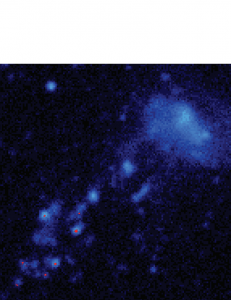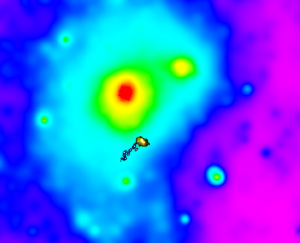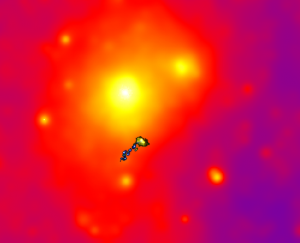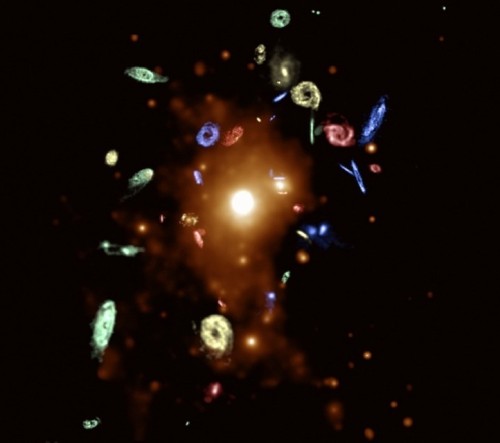
In a paper recently submitted to the Astrophysical Journal, Yale astronomers have identified a small dwarf galaxy as the first observed example of the process of galactic death. “It’s been a mystery for a long time how small galaxies lose all their gas, or become ‘dead,’” said Jeffery Kenney, a professor in Yale’s Department of Astronomy and the principal investigator. “The answer has been suspected for many years, but we haven’t found a clear, smoking gun example of the process actually happening. This galaxy is the smoking gun example.”

The galaxy, called IC3418, is part of the Virgo galaxy cluster, the closest cluster to our own Milky Way galaxy. A galaxy cluster is a group of galaxies that orbit around each other. Each galaxy in the cluster is made of gas, and gas is also spread throughout the cluster. As the gas of the galaxy and the gas of the cluster move relative to each other, a “ram pressure,” proportional to the density of the gasses and velocity of relative movement, is exerted by the cluster gas on the gas in the galaxy. This causes gas to be pushed out of the galaxy in a process known as “ram pressure stripping.”

There are two different types of dwarf galaxies found in the universe: “galaxies with gas and star formation, which astronomers call ‘dwarf irregular,’ and galaxies with no gas and star formation, called ‘dwarf elliptical,’” explained Kenney. “The ‘dwarf irregular’ is still turning gas into stars, and is still alive in that sense. In the dwarf elliptical, all the stars are older; it’s not making new stars anymore, so in that sense the galaxy is ‘dead.’” The new research demonstrates the relationship between the two types: dwarf irregulars turn into dwarf elliptical galaxies through the process of ram pressure stripping.

“What’s especially interesting about this galaxy,” Kenney added, “is that it has a trail of young stars behind it.” As gas is pushed out of the galaxy, it forms a “tail” of hot gas behind it in the cluster, which can lead to star formation. In IC3418, the formation of young stars was observed in tail centered on one side of the main body of the galaxy, a distinctive feature that is a clear signature of ongoing ram pressure.
The star formation in the tail of IC3418 is also an example of what Kenney calls “fireballs”—balls of gas that are dense enough to form stars. These “fireballs” in the galaxy’s tail are accelerated out from the galaxy by ram pressure. However, ram pressure does not affect the massive newly formed stars. These stars are gravitationally bound to the galaxy, and since they have a small surface area, the force from ram pressure (proportional to pressure times area) leaves them unaffected. The newly formed stars then decouple from the accelerating “fireballs” and get deposited behind them, leaving the tail of young stars that researchers observe.

Information about IC3418 was first collected during a survey of the Virgo cluster done by with NASA’s Galaxy Evolution Explorer (GALEX) ultraviolet satellite, which showed the formation of young stars in the tail. Yale researchers followed up on these observations during their own survey of the Virgo cluster, comparing images of the galaxy at different wavelengths, including optical, ultraviolet, x-ray, and H-alpha, a visible wavelength created by the emission of hydrogen from the galaxy.
The ultraviolet images “show you star formation that happened over the past hundred million years, whereas H-alpha emission shows what’s been going on for the past 10 million years,” said Kenney. “This picture of H-alpha emission shows you where star formation is happening right now,” he added. The H-alpha emissions are bright knots showing new stars, while the ultraviolet images illustrate a fainter tail behind the new star, pointing back toward the galaxy. This elongation of the ultraviolet images, Kenney explained, is the “clue that there may be force acting on them in that way.”

“I’m interested in galaxy evolution and formation” Kenney said, “and I like to study nearby galaxies because I can get a lot of detailed information. A lot of astronomers study very distant galaxies, which are very interesting. But, they’re mostly point sources, so you can’t get much information about each one.” In contrast, the wealth of information and available for nearby galaxies like IC4318, Kenney explained, allows astronomers to constrain possible evolutionary scenarios and ultimately “come up with an interpretation and make a story.”
